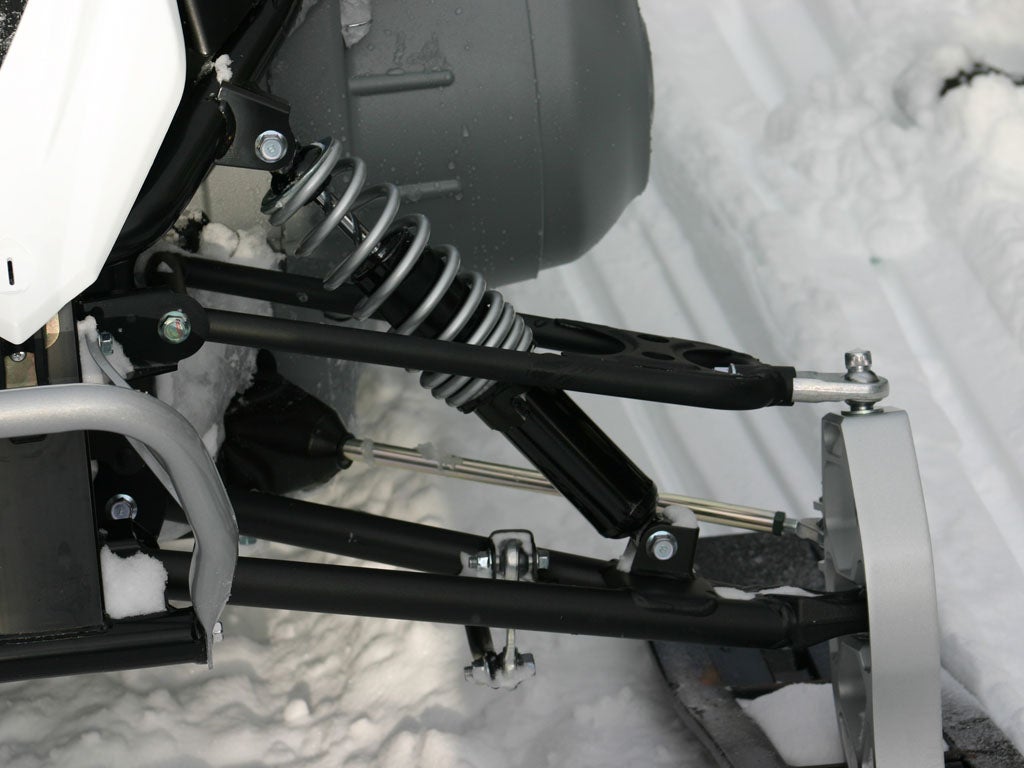When Yamaha released images of the Phazer to the press last spring the snowmobile population took great interest in this new and innovative sled that uses a lot of technology borrowed from its YZ cousins. But looking past the cool design the spec sheet on the Phazer is not as impressive as its design. While it does have good suspension and ergonomics the two most talked about numbers; weight and horsepower are not as impressive. According to Yamaha the Phazer Mountain Lite weighs in at 514lbs and the twin cylinder four-stroke 500 pumps out roughly 80 horsepower. The power to weight ratio is about half that of other machines on the market so we were less than thrilled with the prospect spending a weekend on a Phazer in the steep and deep snow of Island Park Idaho. Nevertheless we geared up and headed into the mountains on a brand new Phazer Mountain Lite with a few buddies on Yamaha 700 Vipers.

|
When it comes to jumping and dropping the Phazer is in a class of its own. But not climbing! |
 The most impressive feature of the
Phazer is the new sport rider-forward riding position. The tall narrow seat and
high handle bars put the rider forward and over the skis. It feels a lot like a
sport quad or dirtbike to ride. This riding position is particularly nice on
rough trails or when boondocking. It does require a very different riding style
than older conventional sleds. Conventional sleds like the Yamaha Viper,
Ski-Doo MXZX chassis, or Polaris Edge, have a less aggressive riding position
and require the rider to put both feet on one side of the running boards to
side-hill or corner sharply. The Phazer on the other hand is easier to rider
with feet on both running boards and in powder requires a lot of counter
steering to change direction. It was interesting to switch back and forth
between the Viper and Phazer and compare the differences that a few years of
design development has achieved. Riders coming from other rider-forward sleds
like the Ski-Doo REV will be more likely to feel at home on the Phazer.
The most impressive feature of the
Phazer is the new sport rider-forward riding position. The tall narrow seat and
high handle bars put the rider forward and over the skis. It feels a lot like a
sport quad or dirtbike to ride. This riding position is particularly nice on
rough trails or when boondocking. It does require a very different riding style
than older conventional sleds. Conventional sleds like the Yamaha Viper,
Ski-Doo MXZX chassis, or Polaris Edge, have a less aggressive riding position
and require the rider to put both feet on one side of the running boards to
side-hill or corner sharply. The Phazer on the other hand is easier to rider
with feet on both running boards and in powder requires a lot of counter
steering to change direction. It was interesting to switch back and forth
between the Viper and Phazer and compare the differences that a few years of
design development has achieved. Riders coming from other rider-forward sleds
like the Ski-Doo REV will be more likely to feel at home on the Phazer.
 The Phazer features double wish
bone front suspension coupled to gas cell hydraulic shocks. Adjustable spindles
allow the rider to change the ski stance from 37.6 to 39.6 inches. The second
generation of the ProMountain suspension is used on the rear, it uses a
cantilever system that is designed to allow the track tension to remain
constant through the compression travel. The front suspension worked really
well on our test sled under all riding conditions but we kept bottoming out the
rear suspension when jumping and riding rough trails. That was with a 180lb
rider with front shock on the firmest setting and the three stage spring
adjuster on the firmest setting.
The Phazer features double wish
bone front suspension coupled to gas cell hydraulic shocks. Adjustable spindles
allow the rider to change the ski stance from 37.6 to 39.6 inches. The second
generation of the ProMountain suspension is used on the rear, it uses a
cantilever system that is designed to allow the track tension to remain
constant through the compression travel. The front suspension worked really
well on our test sled under all riding conditions but we kept bottoming out the
rear suspension when jumping and riding rough trails. That was with a 180lb
rider with front shock on the firmest setting and the three stage spring
adjuster on the firmest setting.
It is impressive how well the Phazer goes through the snow, even with its weight and power handicap it still moves through the powder well. It doesn?t goe fast through powder but it just keeps going. The Mountian Lite comes with a 14" wide 144" Maverik track with 2 inch lugs. Without modifying the engine the Phazer would probably have a hard time turning a larger track.

|
Test rider William Klassen carves the deep early season powder in Island Park |

|
The Phazer was an absolute blast to ride on the trail, aside from the rear suspension being a little soft we had no complaints. |

Author Note: Special thanks to the guys at Bully Dog Technologies www.bullydog.com for the loan of the sleds and helping make this article a reality.
